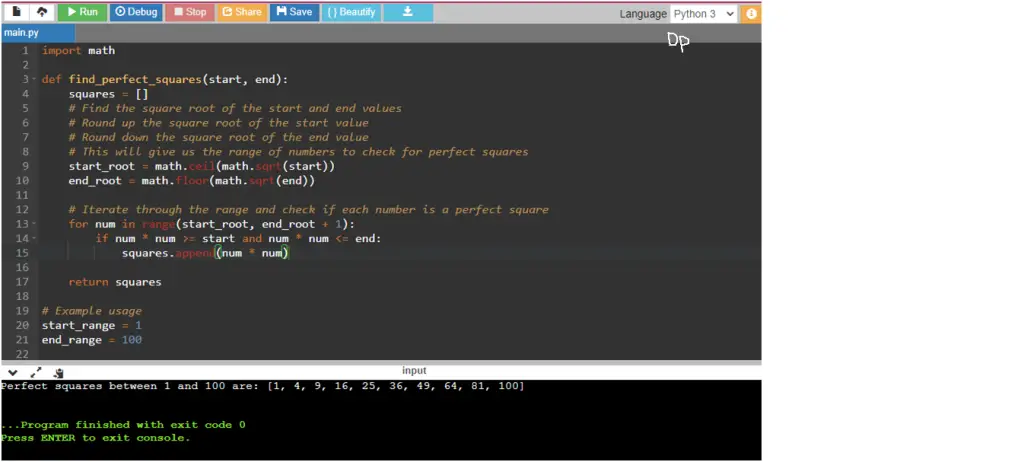Python Program to Find All Perfect Squares in the Given Range
This Python program finds all perfect squares within a given range (inclusive) and displays them as a list. A perfect square is a number that can be expressed as the product of an integer multiplied by itself. For example, 4, 9, 16, and 25 are perfect squares because they can be expressed as 2×2, 3×3, 4×4, and 5×5, respectively.
Program Statement
Given a range specified by the start and end values, we need to find all perfect squares within that range (including both the start and end values) and display them as a list.
Python Program to Find All Perfect Squares in the Given Range
import math
def find_perfect_squares(start, end):
squares = []
# Find the square root of the start and end values
# Round up the square root of the start value
# Round down the square root of the end value
# This will give us the range of numbers to check for perfect squares
start_root = math.ceil(math.sqrt(start))
end_root = math.floor(math.sqrt(end))
# Iterate through the range and check if each number is a perfect square
for num in range(start_root, end_root + 1):
if num * num >= start and num * num <= end:
squares.append(num * num)
return squares
# Example usage
start_range = 1
end_range = 100
result = find_perfect_squares(start_range, end_range)
print("Perfect squares between", start_range, "and", end_range, "are:", result)
How it works
- Import the
mathmodule, which provides mathematical functions including square root calculation. - Define a function called
find_perfect_squaresthat takes two parameters:startandend. - Inside the function, initialize an empty list called
squaresto store the perfect squares. - Calculate the square root of the
startvalue usingmath.sqrt()and round it up usingmath.ceil(). Assign the result tostart_root. - Calculate the square root of the
endvalue usingmath.sqrt()and round it down usingmath.floor(). Assign the result toend_root. - Iterate through the range from
start_roottoend_root + 1. - For each number in the range, check if its square falls within the given range (
startandend). - If the square of the number falls within the range, append it to the
squareslist. - After iterating through all the numbers, return the
squareslist. - Outside the function, prompt the user to enter the
start_rangeandend_rangevalues. - Call the
find_perfect_squaresfunction with the enteredstart_rangeandend_rangevalues, and assign the result to a variableresult. - Print the start and end range values.
- Print the list of perfect squares found within the range.
The program calculates the square root of the start and end values to determine the range of numbers to check for perfect squares. It then iterates through this range, checks if each number squared falls within the given range, and appends the perfect squares to a list. Finally, it displays the list of perfect squares found within the given range.
Input/Output





Leave a Review